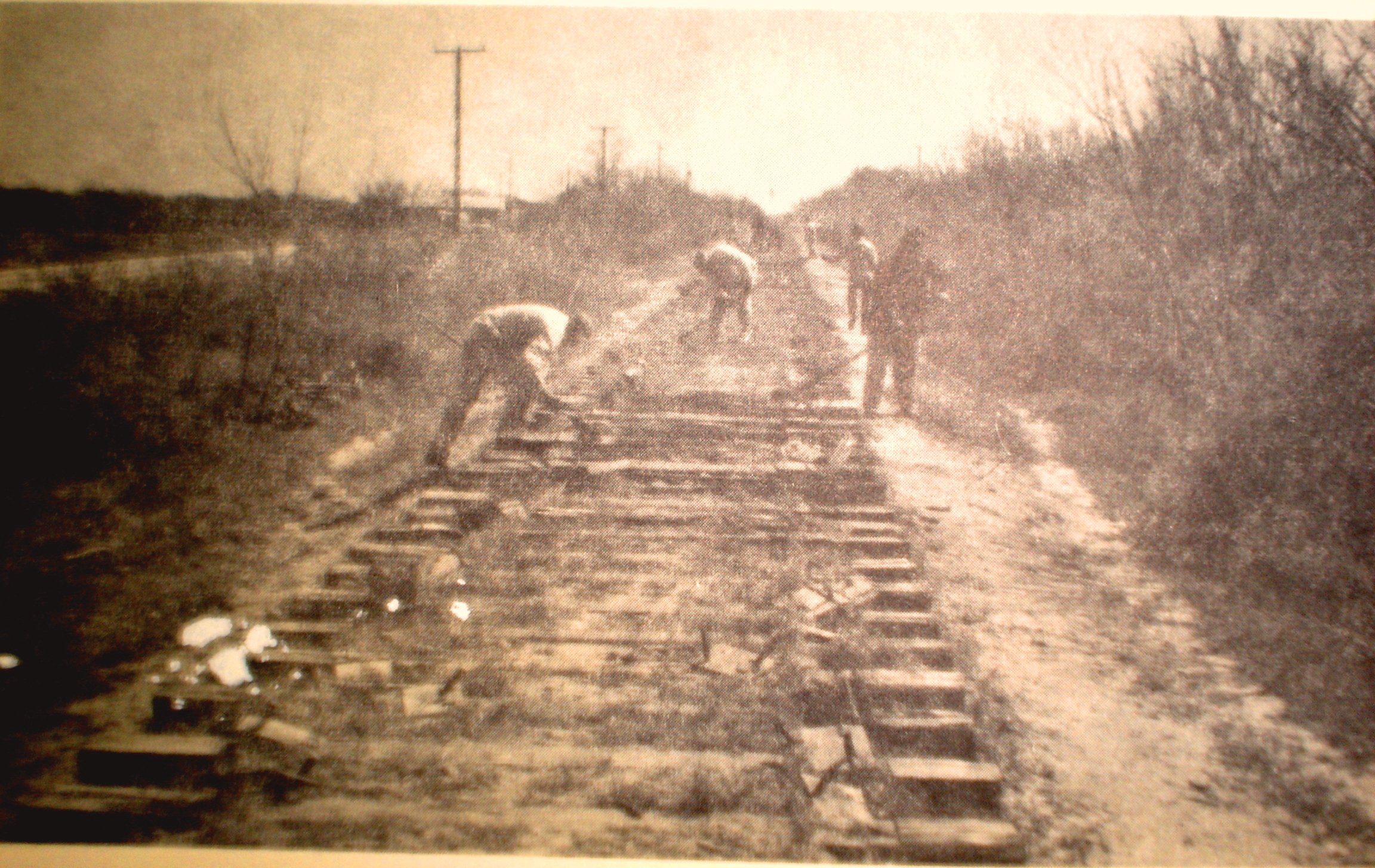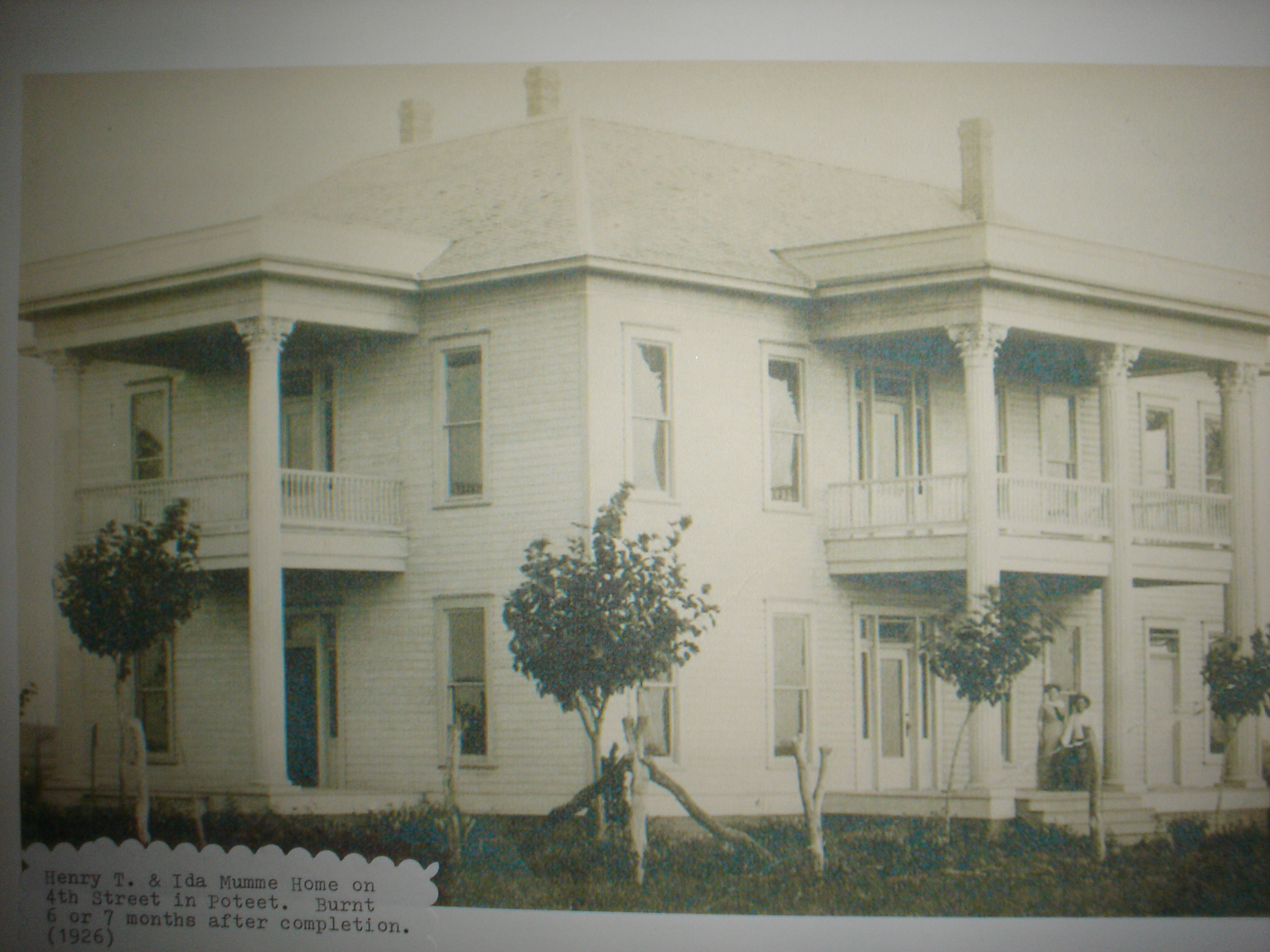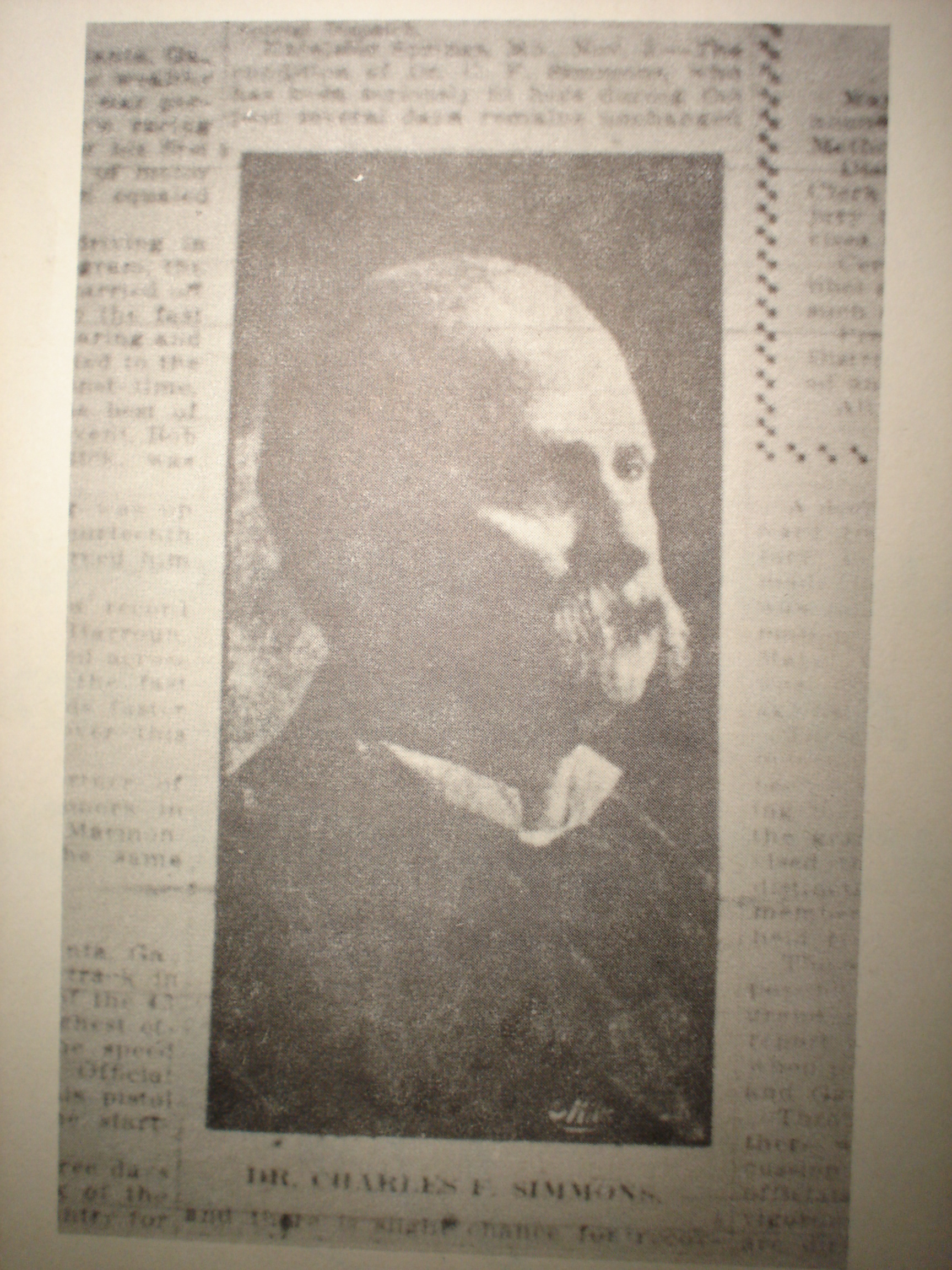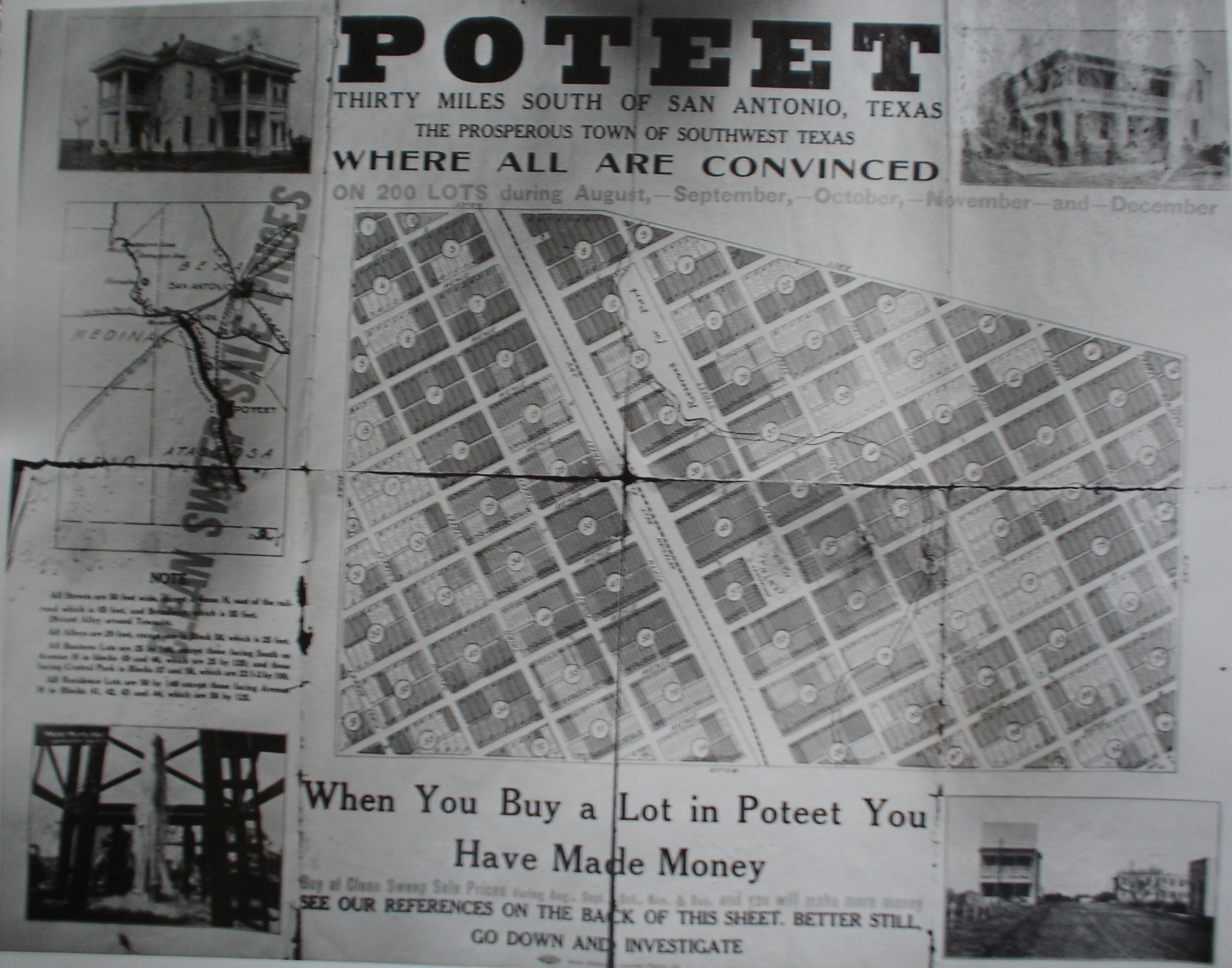

"FOUNDING FATHERS AND MOTHERS": After the American Civil War, a discharged Confederate soldier named Francis Marion Poteet opened a store and blacksmith shop twenty-seven miles south of San Antonio, in Atascosa County, called the Pioneer One Way Stop. Poteet opened this to cater to travelers going between San Antonio and Corpus Christi. Eventually, he built a mill, farm, and ranch where he raised cattle and goats. It is said that the mail delivered to Poteetís store is what gave Poteet its name. Poteet was the postmaster for a while before he sold the store and post office to Henry T. and Ida Fischer Mumme. The Mummes became the two most instrumental people in the development of Poteet. Like Poteet, the Mummes raised cattle. After the drought that hit Poteet in 1902, they became worried about supplying water and pasturage to his cattle, so in 1904, after many unsuccessful digs, he hired a digging crew. Mumme told the crew to drill deep and they eventually hit the Carrizo strata. The digging crew had drilled the first Artesian well in Atascosa County as well as one of the first in Texas. The abundance of water brought new development to the area, and eventually the area became known as the Artesian Belt of Texas. Later that name was borrowed by a railroad builder to name his new rail company.

The Railroad: Charles Simmons started the Artesian Belt Railroad, which eventually made itís way through Poteet. The railroad was built because Simmons knew that it was difficult to sell land if the prospective buyers could not come to inspect the land being sold. After the railroad passed through Somerset, it went onto Poteet. Knowing the importance of the railroad the Mummes decided to donate the land, 300 acres, in order to have the railroad built and run through Poteet. Although the railroad was only operational for about thirty or forty years, for the time that it was running, it brought economic growth to the land. Along with the growth of the economy came the growth of the population.
.jpg)

ECONOMY:
The dominant industry in Poteet since its birth has been agriculture. Many things have thrived in its rich, sandy soils, including watermelons, beans, lettuce, onions, and cattle. Currently, the most common produce grown there are peanuts and strawberries, but agriculture does not have as strong of a hold on Poteetís economy, which has modernized like many other small communities.
The median household income, as of 1999, in Poteet is $25,329, where as the annual income of the average household in Texas, as of 1999, is $39,927, and in the US is $41,994. The economic status of the white versus the Hispanic population shows how Poteetís economy mirrors the US economy, on a smaller scale. Although the white population is not as large as the Hispanic population, white households earned, on average, about $2,000 more a year in 1999. The communityís population is 89% Hispanic, the rest being mostly European.
Between 1960 and 1990, there were about 2,262 houses built in and around the town of Poteet. This suggests that Poteetís economic status and population were progressing, and Poteet was expanding at a fast rate. It seems that the population and economic status are still growing at a fairly fast pace. In only five years, from 1990 to 1995, there were 202 houses built, and only three years after that, from 1995 to 1998, there were 533 houses built. In the eight year span, from 1990 to 1998 there was a total of 735 houses built.
As of 2000, the average value of houses in Poteet is between $40,000 and $70,000. The average cost for rent is between $150 and $350. Most people in Poteet commute to work. It takes the average person from 30 to 59 minutes to get to work, most of which are commuting to their jobs in San Antonio.
The picture below is an add that was posted to sell the plots of land. It also shows where the Artesian Belt Railroad went through town.

Coal in Poteet
At one point, Poteet supplied a large amount of the fuel that was used in San Antonio. The first commercial coal operation was started by a man named Marius Chieuse. Chieuse came from Weidelsheim, Alsace, France. Upon purchasing several thousand acres of land, he dug the high-grade lignite and hauled it by wagon train to San Antonio, where it was sold as fuel. As mining lignite became less and less profitable, Joseph H. Burger, Chieuseís nephew, had to look for some other source to mine. When the Artesian wells were being dug, it was noticed that coal was coming up, and that was what prompted Burger to start coal mining. The mine was located south of Poteet. Henry T. Mumme and Mr. Calloway began to develop the mine. In order to do so they dug a shaft about 80 feet and then another about 10 feet to open the levels for the workers. This uncovered a vein that was between nine and 12 inches thick, and about 15 men were employed to mine the coal. Coal cars pulled by a mule were transported through the levels, which were then loaded into an engine power cage lift, brought to the top, and subsequently transported to San Antonio to be sold. After being operational for several years, the mine caught fire and caved in.
Interview with D.L. Hooge:
Aksel: Itís May 5th. I am interviewing Leon Hooge for Small Town Research Project.
Aksel: Can I have your full name?
LD: Leon D. Hooge.
Aksel: Where were you Born?
LD: In Poteet, Texas on April 3rd in 1930.
Aksel: Where were your parents born?
LD: My dad was from Belgium and my mother was from San Antonio.
Aksel: When did your father immigrate to America? Why?
LD: In 1910 I think. His brothers were here working and decide to come over.
Aksel: What school did you go to?
LD: Poteet.
Aksel: What industry did your father work in?
LD: The produce business and farming.
Aksel: What would you say the dominating industry in Poteet was at that time?
LD: Farming.
Aksel: What was life like having your father work in the produce industry?
LD: Well, it was a lot of work. During WW2 I would wake up about 5 oíclock in the moning to grind the meat up and take it to school in the truck. Then I would walk to school, which was about half a mile away, and run home and back for lunch. And when I wasnít in school I would work 12-15 hours a day.
Aksel: Do you know when the railroad left Poteet?
LD: I donít remember maybe around the Ď60s. I know that in 1934-35 we loaded a lot of corn for the service people.
Aksel: How did the railroad leaving affect the economy?
LD: It didnít affect it too much because the truck took the produce out.
Aksel: Was the depression still affecting Poteet when you were a kid?
LD: It was when I was till about the 1940s because that was when the war started.
Aksel: How did it affect the produce/farming industry?
LD: It was mostly a boarder [barter] system. My mother had a grocery store and they would trade the produce. We always had chickens and rabbits to we always had plenty to eat.
Aksel: Were you aware of the affect the depression was having on the economy at that time?
LD: Not really, because I was too young and didnít know much about it.
Aksel: When you were going to school, what was the ration [ratio] of white to black to hispanics?
LD: There werenít any African-Americans in Poteet. They didnít allow them in town. Ten percent Hispanic and the rest were white.
Aksel: How did the races mix?
LD: Poteet was very prejudice back then. A lot of the people in Poteet were prejudice about us because we were foreigners.
FUTURE PROSPECTS: Poteet is a small town, and it one point in time it was almost twice as large as it is now. It is slowly growing, and may eventually become a large city. It could just as easily die out.
Poteet, Texas ANNOTATED BIBLIOGRAPHY:
Atascosa County History, Ed. Atascosa History Committee. Texas: Taylor Publishing Company, 1984.: Had some info, but only a little about Poteet.
Poteet's Story Dates Back to the Pre-Civil War Era, San Antonio Express News.: Got a lot of info from this article. It was indepth and most of it was relevent to the project.
"Poteet, Texas." The Handbook of Texas Online. Peterson, June 6, 2001.: Does not have much information, but is relevnet and to the point.